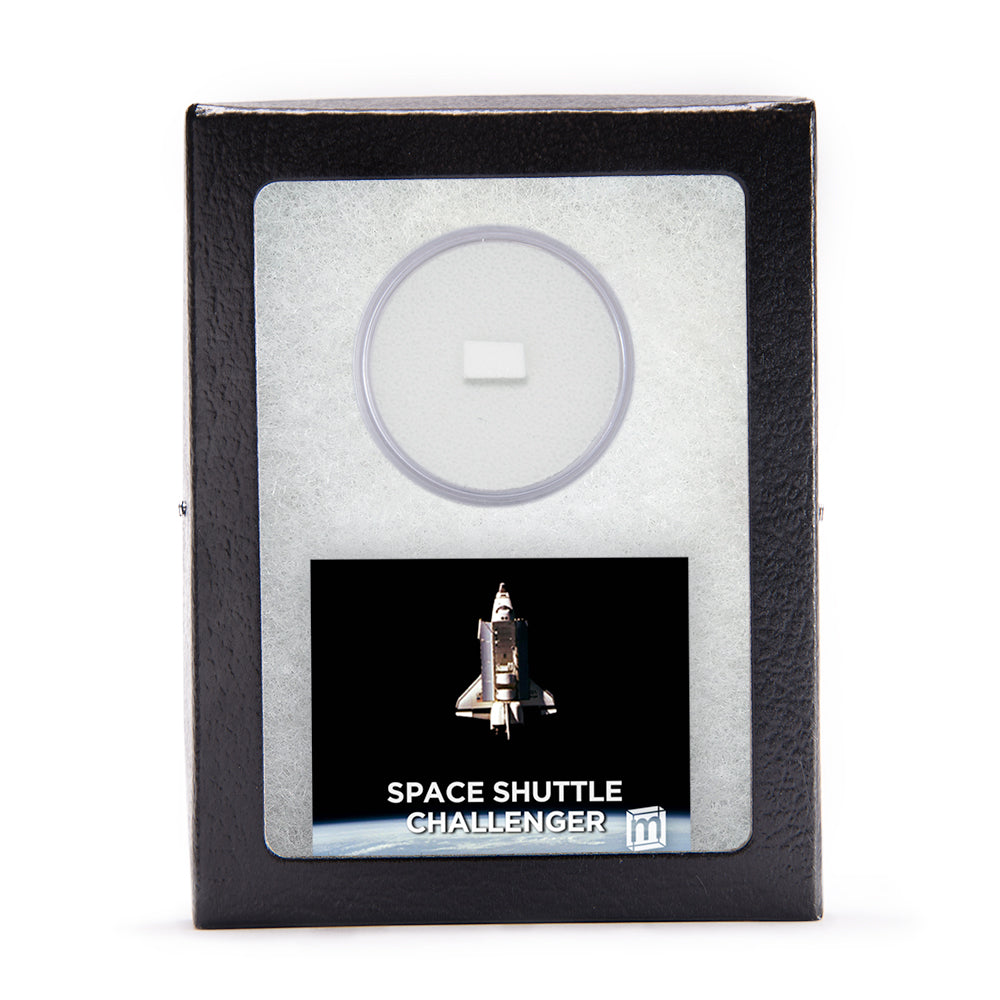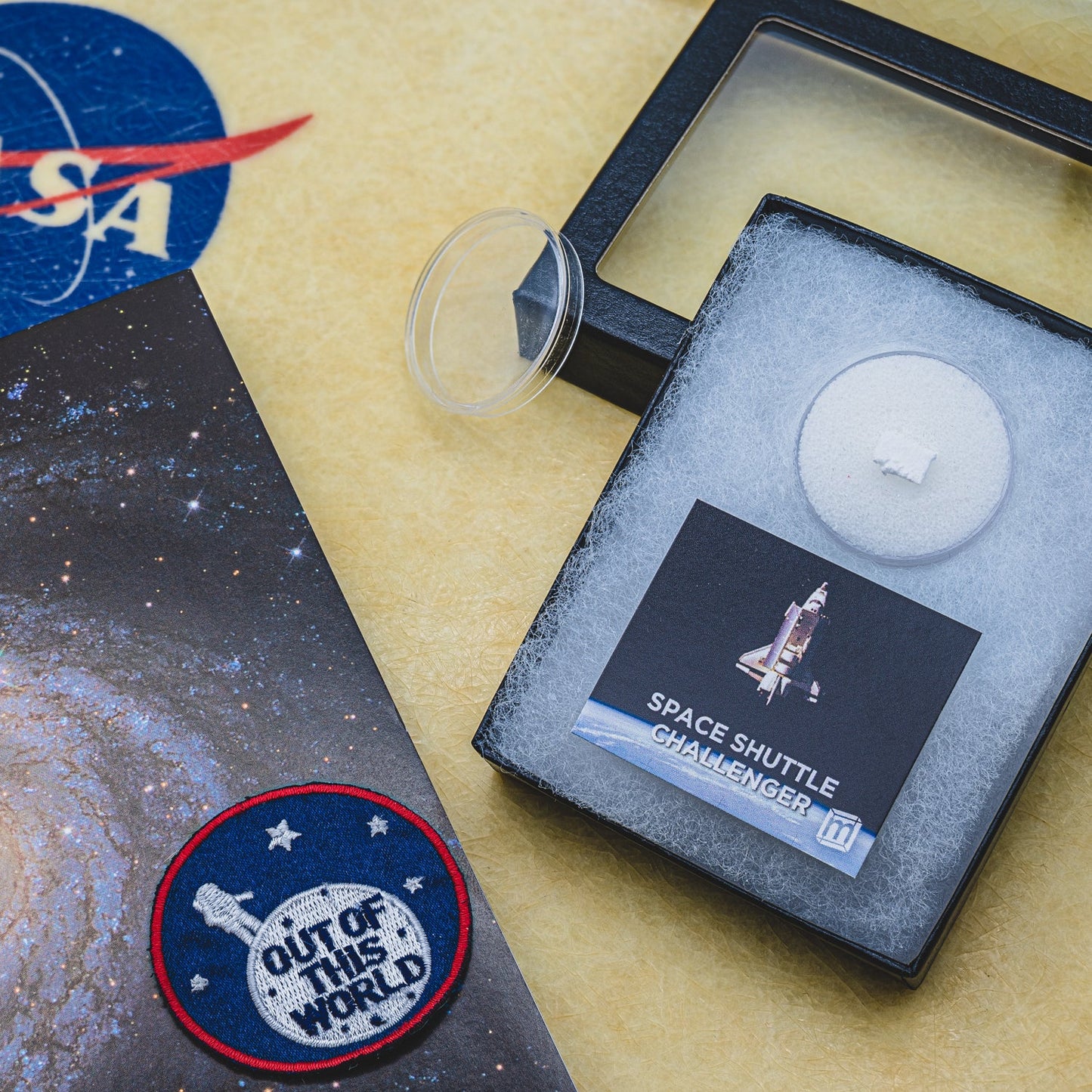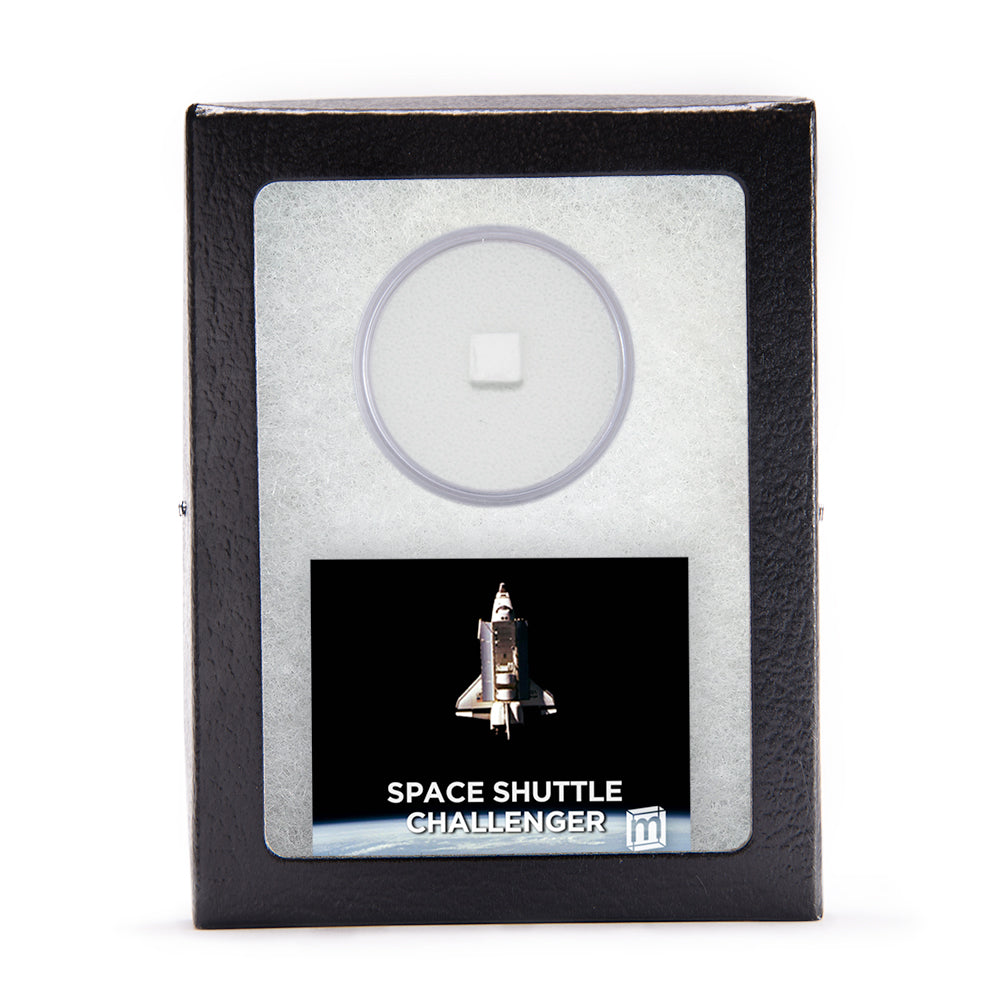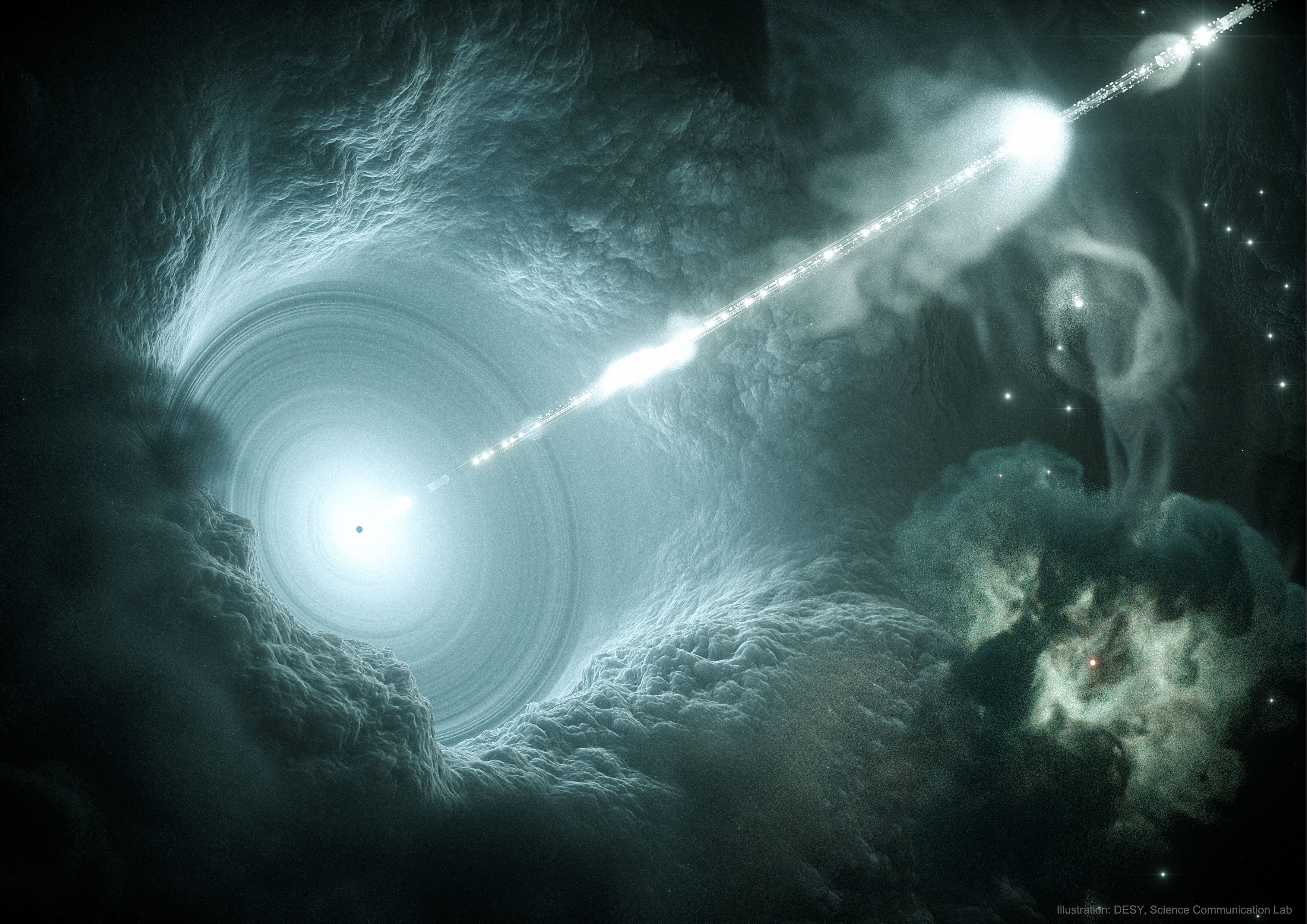Space Shuttle Challenger - Flown LRSI Tile Fragment
Space Shuttle Challenger - Flown LRSI Tile Fragment
Matter Subscriber Price:
Couldn't load pickup availability

Above: Front of the Specimen Card featuring NASA image STS07-32-1702. Taken on June 22, 1983, during STS-7.
The Space Shuttle Challenger (OV-099) was the second of the space shuttles in the program to enter orbit, embarking on its maiden voyage on April 4, 1983. Over the course of its ten missions, the shuttle gathered scientific data, repaired satellites, and brought the first African-American to space, Guion Bluford.
This specimen is a mission-flown tile fragment from the Space Shuttle Challenger. Known as a low-temperature surface insulation tile (LRSI), the tile is comprised of low-density silica. The tiles protected parts of the orbiter exposed to temperatures in excess of 1,200°F and below 0°F.

Above: Space Shuttle Challenger LRSI Tile with typical NASA scrap tags.
Each tile was unique, specifically designed to meet the exact shape, weight, and temperature resistance required at its location on the craft. NASA disposition paperwork received with this item indicates this particular tile was removed after the Challenger’s sixth mission (STS-41-G) which flew on October 5, 1984.

Above: Closeup of the reverse side of the tile. The red coating is actually a silicone adhesive called RTV 560. This phenyl methyl silicone is filled with iron oxide, hence the red color. It has high heat conductivity and was used as the main TPS adhesive. You can read more about these adhesives and much more in the NASA Technical Report "Outgassing Products from Orbiter TPS Materials".
It's not unusual to have tiles replaced as they are designed just for this purpose, but STS-41-G was unusual as a significant number of tiles were damaged during the mission. After careful review, NASA engineers discovered that faulty waterproofing used throughout the Thermal Protection System (TPS) allowed debonding of the tiles. To correct the problem, workers removed and replaced over 4,000 tiles.
As pictured below, each hand-cut specimen is housed in an acrylic jar and ships in a classic, glass-topped riker display case. Specimens measure roughly, 6mmx5mm though variations in shape will occur as the material is rather difficult to cut. A small information card is also included, which serves as the certificate of authenticity.

Above: Why yes, we do have an original NASA cafeteria tray at MMHQ. What else would we use for special luncheons?
Special Handling Notice: We have not stabilized this material. So while the silica is not toxic, it will powder under pressure. If you choose to handle the specimen, please do so with extreme care. We also recommend using gloves as the silica will coat your fingers and can be irritating.
More about Space Shuttle Program and Challenger (OV-099)
"What are we doing here? We're reaching for the stars." ~ Christa McAuliffe (1948-1986) (Source: TIME Magazine February 10, 1986)

Above: The first launch of the Space Shuttle Challenger (STS-6, April 4, 1983). (Source Department of Defense image DF-SC-84-01865)
After the close of the Apollo program, NASA turned its focus from lunar landings to research and observation. The vessel for this new focus would be the Space Shuttle, a multi-use vehicle designed to carry astronauts and scientific equipment to and from Earth's orbit. Due to their reusable design, the orbiters were amazing tools for furthering our scientific understanding of the stars.
NASA's Space Shuttle program delivered 133 successful missions during its three decades in operation, beginning with Columbia's inaugural mission in 1981 and concluding with Atlantis' final mission in 2011. Missions involved many vital tasks, such as maintaining the International Space Station, repairing the Hubble Space Telescope, and deploying satellites. Scientific experiments featured heavily in the rotation, using the reusable Spacelab developed by the ESA.

Above: Challenger hitches a ride on NASA's Boeing 747 Shuttle Carrier Aircraft (SCA), NASA 905. The ferry flight took the orbiter to the Kennedy Space Center in Florida for its first launch. (NASA Image EC82-21135 July 4, 1982)
As noted above, the Space Shuttle Challenger was the second of the space shuttles in the program to enter orbit, embarking on its maiden voyage on April 4, 1983. Over the course of its ten missions, the shuttle gathered scientific data, repaired satellites, and brought the first African-American to space, Guion Bluford. However, despite Challenger’s many achievements, it is remembered in history for its tragic final flight.

Above: STS-51L crew members Michael J. Smith, front row left, Francis R. "Dick" Scobee, Ronald E. McNair; Ellison S. Onizuka, back row left, S. Christa McAuliffe, Gregory B. Jarvis, and Judith A. Resnik. (NASA Image S85-44253 November, 1985)
On January 28, 1986, Challenger began its final flight (STS-51L), disintegrating 73 seconds after takeoff. The explosion was caused by the failure of O-ring seals in the shuttle’s rocket booster, which allowed pressurized gas to burn through to the booster’s fuel tank. This horrific event ended with the deaths of all onboard crew members, which led to a brief suspension of shuttle flights and an overhaul of both the program itself and NASA’s organizational structure.
In 2021, John Uri of the NASA Johnson Space Center posted this touching retrospective of the crew from STS-51L on the 35th anniversary of the disaster. We invite you to read more here: "35 Years Ago: Remembering Challenger and Her Crew".
Further Reading
McDonald, Allan J., and James R. Hansen. Truth, Lies, and O-rings: inside the space shuttle challenger disaster. Gainesville: University Press of Florida, 2009.
Vaughan, Diane. The Challenger launch decision: Risky technology, culture, and deviance at NASA. University of Chicago Press, 1996.
Lamoreux, James C., James D. Siekierski, and JP Nick Carter. "Space Shuttle thermal protection system inspection by 3D imaging laser radar." Laser Radar Technology and Applications IX. Vol. 5412. SPIE, 2004.
PITTS, W., and D. KOURTIDES. "Ceramic insulation/multifoil composite for thermal protection of reentry spacecraft." 24th Thermophysics Conference. 1989.
Linton, Roger C., Ann F. Whitaker, and Miria M. Finckenor. "Space environment durability of beta cloth in LDEF thermal blankets." LDEF Materials Results for Spacecraft Applications (1993).
Harris, Richard, Michael Stewart, and William Koenig. "Thermal Protection Systems Technology Transfer from Apollo and Space Shuttle to the Orion Program." 2018 AIAA SPACE and Astronautics Forum and Exposition. 2018.
Jenkins, Dennis R. Space shuttle: the history of the National Space Transportation System: the first 100 missions. DR Jenkins, 2001.
Jenkins, Dennis R. Space Shuttle: Developing an Icon: 1972-2013. Specialty Press, 2016.

Above: Back of the Specimen Card



Shop collections containing this item:
Aeronautics Engineering Historic Artifacts In Stock Mini Museum Newest Listings Outer Space Space Flight Artifacts Stemcell Catalog Storewide

AUTHENTICITY GUARANTEED
We only list 100% verified authentic items. We work with reputable collectors, and regularly consult with our network of scientists and experts.
-
Free Shipping
Spend $50 to qualify for free US shipping
-
Secure Payments
Pay how you like: Credit card, PayPal, After Pay, Shop Pay, Venmo, Apple/Google/Meta Pay & crypto
-
Simple Returns
Change your mind? No problem. Enjoy easy returns within 30 days.
WE TAKE SCIENCE SERIOUSLY
You deserve better than craft store science products. And we think learning is more impactful when you're holding a tangible piece of what you're learning about. That's why Stemcell exists.
We're dedicated to providing the best scientific products available—whether they're fragments of scientific importance, experimental activities, or just interesting things that scratch your curiosity itch.
With every new product launch, our list of new ideas gets longer rather than shorter. So check in often for our latest projects, and thanks for being a part of our endeavor to make the world a smarter place to live.
Believe in yourself; for everything else, there's science.
— TERRY MUDGE, FOUNDER & SCIENTIFIC DIRECTOR


